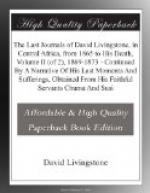Footsteps of Moses. Geology of Manyuema land. “A drop of comfort.” Continued sufferings. A stationary explorer. Consequences of trusting to theory. Nomenclature of Rivers and Lakes. Plunder and murder is Ujijian trading. Comes out of hut for first time after eighty days’ illness. Arab cure for ulcerated sores. Rumour of letters. The loss of medicines a great trial now. The broken-hearted chief. Return of Arab ivory traders. Future plans. Thankfulness for Mr. Edward Young’s Search Expedition. The Hornbilled Phoenix. Tedious delays. The bargain for the boy. Sends letters to Zanzibar. Exasperation of Manyuema against Arabs. The “Sassassa bird.” The disease “Safura.”
Bambarre, 25th August, 1870.—One of my waking dreams is that the legendary tales about Moses coming up into Inner Ethiopia with Merr his foster-mother, and founding a city which he called in her honour “Meroe,” may have a substratum of fact. He was evidently a man of transcendent genius, and we learn from the speech of St. Stephen that “he was learned in all the wisdom of the Egyptians, and was mighty in words and in deeds.” His deeds must have been well known in Egypt, for “he supposed that his brethren would have understood how that God by His hand would deliver them, but they understood not.” His supposition could not be founded on his success in smiting a single Egyptian; he was too great a man to be elated by a single act of prowess, but his success on a large scale in Ethiopia afforded reasonable grounds for believing that his brethren would be proud of their countryman, and disposed to follow his leadership, but they were slaves. The notice taken of the matter by Pharaoh showed that he was eyed by the great as a dangerous, if not powerful, man. He “dwelt” in Midian for some time before his gallant bearing towards the shepherds by the well, commended him to the priest or prince of the country. An uninteresting wife, and the want of intercourse with kindred spirits during the long forty years’ solitude of a herdsman’s life, seem to have acted injuriously on his spirits, and it was not till he had with Aaron struck terror into the Egyptian mind, that the “man Moses” again became “very great in the eyes of Pharaoh and his servants.” The Ethiopian woman whom he married could scarcely be the daughter of Renel or Jethro, for Midian was descended from Keturah, Abraham’s concubine, and they were never considered Cushite or Ethiopian. If he left his wife in Egypt she would now be some fifty or sixty years old, and all the more likely to be despised by the proud prophetess Miriam as a daughter of Ham.
I dream of discovering some monumental relics of Meroe, and if anything confirmatory of sacred history does remain, I pray to be guided thereunto. If the sacred chronology would thereby be confirmed, I would not grudge the toil and hardships, hunger and pain, I have endured—the irritable ulcers would only be discipline.




